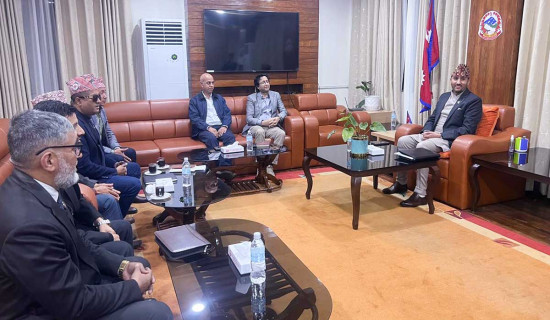- Wednesday, 17 December 2025
Manage Cholera Outbreak Efficiently
With some core areas of the Kathmandu Valley reporting cholera cases, it is time for everyone to remain alert against this disease. As a highly transmissible illness, cholera causes severe diarrhea and vomiting leading to severe dehydration with muscular cramps. Patients suffering this disease can die if they do not get treatment in time.
As of July 14, 2022, some 27 cases of cholera have been confirmed in the capital valley. Health exports have warned that cholera may spread faster in the community level if more effective measures are not taken in time. Though the number of infected people is few until now, it could transmit rapidly as the monsoon season offers a suitable environment for the bacterial growth. Cholera outbreaks occur almost every year during the monsoon in Nepal. According to media reports, cholera cases have detected in Sanepa, Kapan, Koteshwor Bagbazar, Bhotebahal, Dillibazar and other densely populated areas.
Transmission
One can catch this disease by drinking polluted water or having contaminated food with cholera bacteria. The source of contamination is usually the faeces of infected persons that pollute water or foods. The disease can spread promptly in areas with inadequate treatment of sewage and drinking water. It is an acute diarrheal illness in intestine caused by infection with the toxigenic bacterium named Vibrio cholerae serogroup o1.
Globally, an estimated 1.3 million people suffer from cholera each year, and 21,000 to 143,000 persons die from it. Most people often have mild or no symptoms, but it can kill people when they do not get timely treatment. A rough estimate shows that one in 10 people suffering from cholera will develop severe symptoms like frequent watery stool, projectile vomiting along with leg muscle cramps. The rapid onset of disease with massive loss of fluid in the form of stool and vomiting leads patients to severe dehydration and shock. In such a serious situation, patient needs prompt rehydration therapy to correct electrolyte balance with appropriate chemotherapy, otherwise death can occur within hours. Even through cholera falls into a group of water-borne diseases, it can easily be transmitted through contaminated food stuffs. With poor sanitation and hygiene, Nepal is highly vulnerable to water-borne diseases. So long as we fail to maintain environmental health and hygiene properly, it may difficult for us to save people from this illness.
Let us have a cursory glance over the recent uptick in cholera in the Kathmandu Valley, it could just be the tip of iceberg. Since there could be many more people suffering from cholera, they must be identified at the earliest and treated. People showing symptoms of cholera such as leg cramps, profuse watery stool, fatigue and vomiting ought to contact the nearest health facilities immediately. Nevertheless, to prevent cholera and other diarrheal disorders from polluted water universal access to safe drinking water and sanitation should be enhanced. Washing hands with soap and water before handling food and after defecation is necessary for preventing cholera and other communicable diseases. Besides, drying dishes including other utensils in the day light after washing them, using latrine and keeping the household environment clean will go a long way in keeping the cholera and other water-borne diseases away.
The detection of this fatal disease in the valley is a matter of serious concern. The spread of disease suggests that the situation is worrying, given that all infected individuals have diarrhoeal symptoms. The infection might have been spread to many places of the valley as only around 10 per cent of infected people get severely ill from it. Moreover, 80 to 90 per cent of infected people might not be aware of the disease and could be unwillingly spreading it to others. Exports say that the bacteria may present in the faeces of an infected person for up to 10 days. Water samples from household taps and other water sources in affected areas were found contaminated with Escherichia coli, Vibrio cholerae and coliform, the microbes which cause the disease. The World Health Organisation (WHO) states that cholera is a global threat to public health and an indicator of inequality and a kind of lacking in social development. It is believed that the garbage strewn around the Kathmandu Valley for months could have also led to a rise in cholera cases in early June this year.
Priority
According to a survey conducted by the Department of Health Services in affected areas, about 70 per cent water samples were fully contaminated with harmful pathogens. In such a situation, top priority should be given to containing the illness as soon as possible. Lastly, it goes without saying that so long as we fail to comply with public health protocol we can't avoid the unwanted burden of cholera outbreak in our society. People themselves should take precautionary measures to stem the risk of cholera outbreak. Everyone must drink boiled and hygienic water only. All of us are vulnerable to water-borne diseases like cholera. The responsible authorities like the Kathmandu Upatyaka Khanepani Limited (KUKL), and local governments must ensure that all the citizens are receiving clean and hygienic water to prevent cholera and other contagious diseases.
(Chaulagain is a retired public health officer of Nepal government.)

















